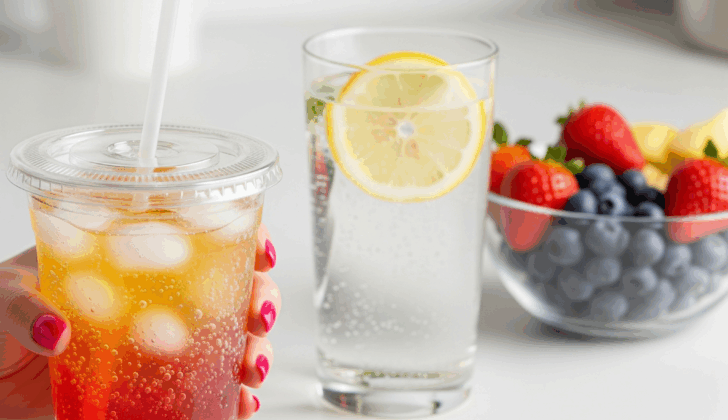It’s no secret that eating too much sugar isn’t great for your health—but did you know sugary drinks may be even worse than sweet foods when it comes to raising your risk for type 2 diabetes?
Many of us think of soda, sweetened teas, sports drinks, or even juice as harmless beverages. But recent research has shown that liquid sugar hits your body differently—and not in a good way. In fact, sugary drinks are now being called one of the biggest dietary culprits in the rising diabetes epidemic.
Let’s break it down: why sugary drinks are more dangerous than sweet foods, what the science says, and how you can take small steps to protect your health without giving up all the sweet things in life.
What Counts as a Sugary Drink?
Sugary drinks include:
-
Regular soda (Coke, Pepsi, etc.)
-
Sweetened iced teas
-
Fruit punch and juice cocktails
-
Energy drinks
-
Flavored waters with added sugar
-
Some store-bought smoothies and coffee drinks
Even 100% fruit juice, while natural, contains high levels of natural sugars without fiber—which still impacts blood sugar.
Why Are Sugary Drinks Worse Than Sweet Foods?
Here’s the thing: liquid sugar is absorbed much faster by the body than sugar in solid food. That leads to:
-
Quick blood sugar spikes
-
Higher insulin release
-
More fat storage
-
Greater insulin resistance over time
Sweet foods like cake or candy still contain sugar, but they often include fiber, fat, or protein, which slow down digestion and help reduce the sugar surge in your bloodstream.
With sugary drinks, there’s no buffer—it’s a straight shot of sugar, fast-tracked into your system.
The Diabetes Link: What the Research Says
According to a large 2023 study published in The BMJ, drinking one or more servings of sugary beverages per day was linked to a 20–25% higher risk of developing type 2 diabetes.
Even more striking: the risk from sugary drinks was significantly greater than from sweet foods with the same amount of sugar.
Other key findings:
-
People who replaced sugary drinks with water or unsweetened tea/coffee had a significantly lower diabetes risk
-
Artificially sweetened drinks didn’t show the same risk as sugar-sweetened ones—but experts urge caution until long-term effects are better understood
-
High sugar intake from beverages can also lead to weight gain, which is another major diabetes risk factor
Sugary Drinks and Belly Fat
Sugary drinks are especially dangerous because they contribute to visceral fat—the fat stored deep in your belly around your organs. This type of fat is highly linked to insulin resistance and inflammation.
Even people who appear “thin” can have high levels of visceral fat if they drink a lot of sugary beverages.
But Isn’t Sugar Just Sugar?
Not quite. While all added sugar affects your body, how it’s delivered matters. Eating a cookie may raise your blood sugar, but it takes longer to digest, and it might contain fiber, fat, or protein that slows down the sugar spike.
When you drink sugar, there’s no chewing, no delay, and no barrier. The sugar hits your bloodstream hard and fast—like a metabolic shockwave.
Who Is Most at Risk?
People at the highest risk from sugary drinks include:
-
Those with prediabetes or a family history of diabetes
-
Individuals who drink soda or sweetened beverages daily
-
Children and teens (whose habits can shape lifelong risk)
-
People with high abdominal fat or a sedentary lifestyle
But really—anyone who regularly consumes sugary drinks can benefit from cutting back.
Healthy Swaps: What to Drink Instead
You don’t have to give up all sweet flavors, but making small changes can protect your long-term health. Try these swaps:
| Instead of… | Try this… |
|---|---|
| Regular soda | Sparkling water with lemon or fruit slices |
| Sweetened tea | Unsweetened iced tea with a dash of honey |
| Fruit punch | Water infused with berries or citrus |
| Juice | Whole fruit (with fiber!) or watered-down juice |
| Energy drinks | Water + electrolytes or herbal tea |
Need a little fizz? Carbonated water with a splash of 100% juice is a great low-sugar, satisfying option.
What About Sweet Foods?
Sweet foods still matter—especially if eaten in large amounts or frequently. But the key is moderation and context.
-
Pair sweets with protein (e.g., fruit with nuts or yogurt)
-
Eat sugary treats after meals, not on an empty stomach
-
Choose whole foods over ultra-processed snacks
And remember: it’s easier to overconsume sugar in drinks because they don’t make you feel full—your body doesn’t register liquid calories the same way.
Small Steps = Big Impact
If you drink soda or sugary beverages regularly, even cutting back by one drink a day can improve your health over time. Aim to:
-
Drink water as your go-to beverage
-
Read labels—many “healthy” drinks have hidden sugars
-
Set a weekly goal (e.g., 5 sugary drinks max per week)
-
Try a 30-day no-soda challenge with a friend
Remember: it’s not about perfection—it’s about progress.
Final Thoughts: Time to Rethink Your Drink
Sugary drinks may seem harmless, but science shows they carry a serious risk—especially when it comes to type 2 diabetes. While occasional treats are okay, making smart swaps in your daily drink choices can help you stay healthier, prevent disease, and feel better in the long run.
Your glass can still sparkle—just skip the sugar.
For more healthy living resources:
MDS: Coffee and Healthy Aging in Middle-Aged Women: A Warm Cup of Wellness











